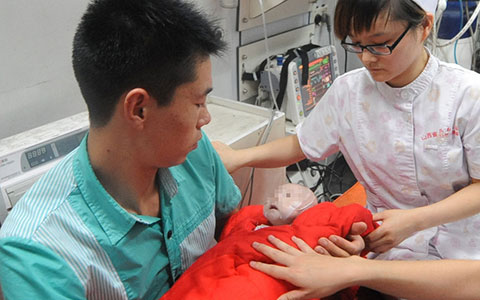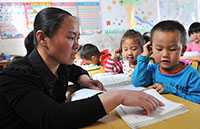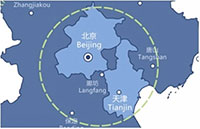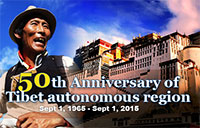National Human Rights Action Plan of China (2012-2015)
(Xinhua) Updated: 2012-06-11 16:20(2) Right to basic living standards
China will maintain steady and rapid economic development, adjust the income distribution pattern, implement poverty alleviation projects, improve the basic housing security system, protect farmers' rights and interests related to land according to law and improve the level of citizens' basic rights of life.
- The increase of rural and urban residents' income will keep pace with economic growth. From 2011 to 2015, the average annual growth rate of China's GDP is expected to be 7%, and the annual growth rate of the per-capita disposal income of urban residents and per-capita net income of rural residents will be over 7%. The income distribution pattern will be adjusted, the share of personal income in the distribution of national income will be increased, so will that of work remuneration in primary distribution; the proportion of middle-income earners will be expanded and the income of middle- and low-income earners will be increased.
- Implementing the Outline of Development-oriented Poverty Reduction for China' s Rural Areas (2011-2020). The state will gradually raise the standards for poverty alleviation. Key poverty reduction projects will be launched for 24,000 villages, where most of the villagers are hit hard by poverty. The government will also conduct training programs in practical skills for the impoverished laborers in rural areas. It will organize migration for people in areas with harsh living conditions on condition that they can do it out of their free will. It will continue to carry out poverty reduction pilot projects in border, endemic-disease-stricken and post-disaster reconstruction areas, and other poverty-stricken areas. It will continue to support such areas with science and technology, and send technicians there to help local people start businesses for the purpose of poverty reduction. Great efforts will be made to develop forestry in poor mountain areas, striving to increase the forest coverage by 1.5 percentage points over that at the end of 2010 and ensure that each impoverished household starts one income-generating project.
- Formulating basic housing security regulations, and improving the construction, distribution, management and exit system of indemnificatory housing. Efforts will be made to speed up the construction of low-rent housing, public rental housing, affordable housing and other types of indemnificatory house, and promote the rebuilding of shanty areas in cities. In so doing, China aims to basically solve the housing problem of low- and lower-middle-income urban families, lessen the housing difficulties of new employees and improve the living conditions of migrant workers. By 2015, the coverage of indemnificatory housing across the country will reach 20%. China will speed up the transformation of shanty areas in forest, reclamation and coal-mining regions. It will renovate dilapidated housing for 815,300 families in forest areas during the 12th Five-Year Plan period.
- Helping impoverished farmer households solve housing safety problems. Efforts will be made to bring into play the guiding role of government financial subsidies in establishing a long-term mechanism for rural dilapidated house transformation. The government plans to help five million impoverished farmer households upgrade their dilapidated houses from 2012 to 2015.
- Implementing the Regulations on the Expropriation of and Compensation for Buildings on State-owned Land, enacting and improving policies and regulations related to housing expropriation to effectively protect the legitimate rights of the owners.
- Doing a good job in land right confirmation, registration and certification so as to effectively protect the farmers' rights to operate their contracted land, to use homesteads and to get income from distribution of collective gains. The state will formulate regulations concerning compensation from the expropriation of rural collective land.
(3) Right to social security
China will improve the various forms of social insurance, and promote the equal coverage of the social relief system in both rural and urban areas to improve the social security level.
- Enacting and amending the supporting rules and regulations of the Social Insurance Law. The state will revise the Regulations on Unemployment Insurance, enact regulations on basic medical insurance and regulations on national security fund, and regulations on maternity insurance and rules regarding the registration, application and payment of social insurance, etc.
- Improving the pension system. By 2015, the number of urban workers and residents underwriting the basic old-age insurance policies will reach 357 million, and the eventual aim is to achieve full coverage of the new rural old-age insurance system and urban employees' pension insurance system. Migrant workers who have established stable labor relations with enterprises will be covered in the basic old-age and medical insurance schemes for urban employees. The state will guarantee the transfer of basic pension accounts for urban workers, and gradually promote the effectual bridging of the rural and urban old-age insurance systems. Efforts will be made to comprehensively implement unified planning in old-age insurance for urban employees and achieve national unified planning for basic old-age pensions. China will endeavor to improve the normal adjustment mechanism for basic pensions to steadily raise the basic pensions for enterprise retirees.
- Improving the basic medical insurance system to make medical insurance basically cover both rural and urban residents in 2015. The total number of people subscribing policies of medical insurance for urban employees, medical insurance for urban residents and new rural cooperative medical insurance will be increased by 60 million as compared with 2010, and the number of people subscribing urban and rural basic medical insurance policies will reach 1.32 billion. Financial grants to those taking policies of urban residents' basic medical insurance and new rural cooperative medical insurance will be raised. The medical treatment cost of inpatients covered by urban employees' medical insurance, urban residents' medical insurance and new rural cooperative medical insurance will all be around 75%. Urban residents' medical insurance and new rural cooperative medical insurance will cover all areas where unified planning in this regard is made, and their coverage of the outpatient expenses will be raised to over 50%. By 2015, the government grant to each person subscribing urban residents' medical insurance and new rural cooperative medical insurance each year will be raised to over 360 yuan, while the coverage of the new rural cooperative medical insurance will be stabilized above 95%.
- Amending regulations and supporting rules on unemployment insurance and further improving the unemployment insurance system. The level of unified planning for unemployment insurance funds will be elevated. By 2015, the number of subscribers to unemployment insurance will reach 160 million.
- Man deported to China in test-taking scandal
- 155 Chinese workers pardoned
- Govt, business propose quantum leap
- Ex-environmental official held in probe
- 'Truth' sought after claims made against Shaolin abbot
- 38.7b yuan in State assets recovered in campaign
- China's future megalopolis gathers momentum as young people return
- Eyes focus on the games as showgirls cover up
- Demand for English-speaking staff soar at workplaces
- Chinese like shopping on US websites







